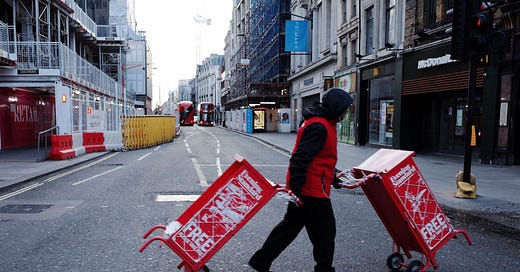Welcome to what is likely to be the hottest ever week in London. But, don’t worry, we can get through this together. Just stay hydrated, stay off the Tube, stay indoors, close the curtains and read newsletters.
Today we’re taking a look at how the fate of ‘London’s newspaper’ has taken even more of a nosedive in recent months; and see what happens when Time Out harks back to the good old days.
As always, our Monday issue is free to read, so if you enjoy it please feel free to share it or post on social media…
Standard disintegrating procedure
A year ago we wrote an issue that attempted to trace just how the Evening Standard had managed to mug itself off quite so spectacularly over the course of the past decade:
We signed that issue off with this paragraph:
“When the Standard finally draws its last breath, they will point to the Internet and coronavirus as the guilty parties. And while that won’t be the most inaccurate thing the Standard has ever printed, it might be the most disingenuous.”
That final breath didn’t come this week, but things definitely started to get a little bit wheezy over there at Lebedev Holdings as the paper filed its finances for the year up to October 2021 and announced a pre-tax loss of £14m.
On the bright side, that’s £3m less than they lost in the previous year, but it does mean that the Standard spent the last five years in the red and haemorrhaged nearly £70m in that time. Plus, even though they lost less money this year, the paper’s turnover dropped by over a third, going from £44m to £28m.
The main reason the paper lost less money this year is because they ‘reduced the workforce’ by over 25%. Meanwhile, the highest paid director (unnamed in the filings) saw his salary go up from £336,000 to £483,000.
Last week, a spokesperson told the Press Gazette that…
“Guided by a constant commitment to outstanding journalism, The Evening Standard continues to play a vital role at the heart of London.”
‘Outstanding journalism’
Now, we can just about ignore the fact that Trojan Condoms still have an entire section of advertorial on the Standard’s website, but we feel like have to point out that the enormous chunk of paid content that’s currently sat right there under ‘News’ in the main menu seems to have been purchased by the UK-based, Indian-born entrepreneur Tej Kohli.
According to the Standard, Tej is “an entrepreneur, investor and philanthropist” who is “on a mission to heal the world’s blind.” Which begs the question: Why is he spending money on advertorial puff pieces?
Well, back in the 90s, Tej was convicted of fraud in the States for his role in a huge real estate con. For that he served four years in prison. After he got out the slammer, Tej made his “billions” running unregulated online casinos and sports betting sites, which (it’s alleged) served US customers at a time when online casinos were prohibited from accepting bets from Americans.
That Forbes article from 2019 also notes that Kohli has spent the past few years making his mark on “the social and philanthropy scene in London in a very public way,” apparently attempting to whitewash his reputation by talking up his “seemingly legitimate projects” in order to create an image that “belies his past as a con man, a casino boss and convict.”
So, if you were wondering what “vital role at the heart of London” the Standard has been playing recently; now you know.
Bank of Lebedev
As you might expect, the Standard’s annual report says that the company “requires further funding” and that money will have to come from the paper’s majority owner, Evgeny Aleksandrovich Lebedev (also known as Lord Lebedev… also known as Baron Lebedev of Hampton and Siberia).
According to the filings, Lord Lebedev has “confirmed… his ongoing commitment to provide adequate funding” for at least the next year. However, should the distinguished peer decide to cut the paper off at any point, there would be “material uncertainty which may cast significant doubt on the company’s ability to remain a going concern”.
Why would Ev’ suddenly decide it wasn’t in his best interests to prop up a failing London tabloid? Well, this report from the BBC from last Thursday very succinctly demonstrates the spotlight on the Evgeny (and his ex-KGB father) and why that spotlight got a little brighter following Boris Johnson’s departure from Downing Street:

(If you really want to go down the rabbit hole on this stuff, Carol Cadwaller published a huge article in yesterday’s Observer detailing all the accusations and murky connections… Including the involvement of one high profile BBC journalist).
Coming up on Wednesday… ✏️
Our subscriber-only issue this week sees a new instalment of our regular ‘Where Do you Go?’ series. This time we speak to graphic designer, photographer, and the man behind London Street Signs, Alistair Hall who tells us about his love of ephemera, the club night he can’t live without, the library that inspires him, and why his local park is “London’s best open space”.
Out of time
Another (once) great London institution, Time Out, published its last print edition at the end of June, with the editor boasting about the million followers they have on Instagram and saying that “A digital product can be as funny, insightful, collaborative and rewarding as a print one. It’s time for us to prove it.”
But then last week (just as Time Out Group’s stock price hit a new 52-week low) a ‘special edition’ of Time Out was printed in order to give the title “a proper send-off”. You can read it online here.
According to the editor’s introduction, the idea behind the special edition was to “celebrate the capital through the eyes of Time Out from our first issue in 1968 to today.” But, by placing new articles next to old, all it really did was bring home just how diluted a once vital and vibrant part of London life had become.
Don’t get us wrong, Time Out is not on the same level as MyLondon - the theatre and art reviews are still pretty good, and the news section is not an algorithmically-generated horror show. But, when you put front page features from the 70s and 80s covering things like the IRA bombings and the Brixton uprising next to a newly-composed list of London ‘highlights from the last decade’ that includes the Diana Memorial fountain (“a serene way to cool down”) and Trafalgar Square (“a place where Londoners come together”)… Well, it’s hard not to conclude that maybe the title lost its way long before the Internet came along and made things a lot trickier for listings magazines.
On a sidenote: Time Out also published its survey of the 53 best Cities in the World last week. London came in at number 17.
5 little bits
Today feels like a good time to remind you that there is an official “map of cool and shaded places of refuge for Londoners” over at london.gov.uk.
There have been more than 800 “grass and open-land” fires in London since the start of June and 70 of those are park fires that were “believed to have been caused by barbecues”. On Saturday evening more than 100 firefighters were called to a huge blaze at a three-storey storage warehouse on Electric Lane in Brixton, right next to the market. There were no reports of any injuries.
A scientific associate at the Department of Life Sciences, has written an article for the journal Megataxa saying that the Natural History Museum is “descending into irrelevance” and that the decision to move “about half of the collections and associated scientific staff to a location outside of London is a self-imposed act of institutional vandalism”. You can read the abstract of the article here.
Previous LiB interviewee, Helen Barrett has just published a report into her recent trip to the renovated Battersea Power Station, which includes some fantastic images of those lovely control rooms, plus the sentence “There are, I’m told, tales of secret escapes through the cable tunnels under the Thames to Chelsea pubs on Friday lunchtimes.”
Posted a day too late to make our Tweet of the Week on Saturday:












